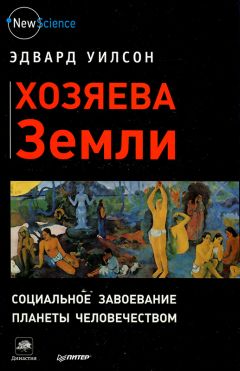Эдвард Уилсон - Хозяева Земли
Определение понятий «эпигенетический» и «эпигенетические правила». Charles J. Lumsden and Edward О. Wilson, Genes, Mind, and Culture: The CoevolutionaryProcess (Cambridge, MA: Harvard University Press, 1981); Tabitha M. Powledge, «Epigenetics and development» BioScience 59: 736-741 (2009).
Цветное зрение. Приведенные в этой главе рассуждения о цветном зрении и колористической лексике в основном заимствованы из работы: Edward О. Wilson, Consilience: The Unity of Knowledge (New York: Knopf, 1998) с привлечением дополнительных, в том числе новейших, данных.
Классификация цветов в разных культурах. Brent Berlin and Paul Kay, Basic ColorTerms: Their Universality and Evolution (Berkeley: University of California Press, 1969).
Эксперименты по классификации цветов представителями народа дани (Новая Гвинея). Eleanor Rosch, Carolyn Mervis, and Wayne Gray, Basic Objects in Natural Categories (Berkeley: University of California, Language Behavior Research Laboratory, Working Paper no. 43,1975).
Восприятие цветов и категории цвета. Trevor Lamb and Janine Bourriau, eds.. Colour: Art & Science (New York: Cambridge University Press, 1995): Philip E. Ross, «Draining the language out of color» Scientific American pp. 46-47 (April 2004); Terry Regier, Paul Kay, and Naveen Khetarpal, «Color naming reflects optimal partitions of color space» Proceedings of the National Academy of Sciences, U.S.A. 104(4): 1436-1441 (2007); A. Franklin et al., «Lateralization of categorical perception of color changes with color term acquisition» Proceedings of the National Academy of Sciences, U.S.A. 105(47): 18221-18225 (2008).
Новейшие исследования по цветовосприятию. Paul Kay and Terry Regier, «Language, thought and color: Recent developments» Trends in Cognitive Sciences 10: 53-54 (2006).
Язык и цветовосприятие. Wai Ting Siok et al„ «Language regions of brain are operative in color perception» Proceedings of the National Academy of Sciences, U.S.A. 106(20): 8140-8145 (2009).
Эволюция цветовосприятия. Andre A. Fernandez and Molly R. Morris, «Sexual selection and trichromatic color vision in primates: Statistical support for the preexisting-bias hypothesis» American Naturalist 170(1): 10-20 (2007).
ГЛАВА 21. КАК ВОЗНИКЛА КУЛЬТУРА
Определение культуры. Toshisada Nishida, «Local traditions and cultural transmission» в книге Barbara В. Smuts et al., eds., Primate Societies (Chicago: University of Chicago Press, 1987), pp. 462-474; Robert Boyd and Peter J. Richerson, «Why culture is common, but cultural evolution is rare» Proceedings of the British Academy 88: 77-93 (1996).
Культура у животных и людей. Kevin N. Laland and William Hoppitt, «Do animals have culture?» Evolutionary Anthropology 12(3): 150-159 (2003).
Как шимпанзе усваивают культурные признаки. Andrew Whiten, Victoria Horner, and Frans В. M. de Waal, «Conformity to cultural norms of tool use in chim-
panzees» Nature 437: 737-740 (2005). О том, как именно обучаются шимпанзе — имитируя движения другого шимпанзе или наблюдая за манипуляциями с предметами, — см. цитату из Майкла Томаселло в работе Грега Миллера, «Tool study supports chimp culture» Science 309:1311 (2005).
Дельфины и использование орудий. Michael Krbtzen et al„ «Cultural transmission of tool use in bottlenose dolphins» Proceedings of the National Academy of Sciences, U.S.A 102(25): 8939-8943 (2005).
Объем памяти у птиц и бабуинов. Joel Fagot and Robert G. Cook, «Evidence for large long-term memory capacities in baboons and pigeons and its implications for learning and the evolution of cognition» Proceedings of the National Academy of Sciences, U.S.A. 103(46): 17564-17567 (2006).
Природа оперативной памяти. Michael Baltar, «Did working memory spark creative culture?» Science 328:160-163 (2010).
Гены и развитие мозга. Gary Marcus, The Birth of the Mind: Howa Tiny Number of Genes Creates the Complexity of Human Thought (New York: Basic Books, 2004); H. Clark Barrett, «Dispelling rumors of a gene shortage» Science 304:1601-1602 (2004).
Происхождение абстрактного мышления и синтаксического языка. Thomas Wynn, «Hafted spears and the archaeology of mind» Proceedings of the National Academy of Sciences, U.S.A. 106(24): 9544-9545 (2009): Lyn Wadley, Tamaryn Hodg-skiss, and Michael Grant, «Implications for complex cognition from the hafting of tools with compound adhesives in the Middle Stone Age, South Africa» Proceedings of the National Academy of Sciences, U.S.A. 106(24): 9590-9594 (2009).
Темпы увеличения мозг? у неандертальцев. Marcia S. Ponce de Leyn et al., «Neanderthal brain size at birth provides insights into the evolution of human life history» Proceedingsofthe NationalAcademy of Sciences, U.S.A. 105(37): 13764-13768 (2008).
История неандертальцев. Thomas Wynn and Frederick L. Coolidge, «А stone-age meeting of minds» American Scientist 96: 44-51 (2008).
Гипотеза интеллекта. Michael Tomasello et al., «Understanding and sharing intentions: The origins of cultural cognition» Behavioral and Brain Sciences 28(5):
, 675-691; commentary 691-735 (2005); Michael Tomasello, The Cultural Origins of Human Cognition (Cambridge, MA: Harvard University Press, 1999).
Сравнение уровня интеллекта у шимпанзе и человеческих детей. Esther Herrmann et al., «Humans have evolved specialized skills of social cognition: The cultural intelligence hypothesis» Science 317:1360-1366 (2007).
Качества развитого общественного интеллекта. Eors Szathmary and Szabolcs SzamadO, «Language: a social history of words» Nature 456: 40-41 (2008).
ГЛАВА 22. ПРОИСХОЖДЕНИЕ ЯЗЫКА
Аргумент в пользу того, что интенциональность предшествовала возникновению языка. Michael Tomasello et al., «Understanding and sharing intentions: The origins of cultural cognition» Behavioral and Brain Sciences 28(5): 675-691; commentary 691-735 (2005). See also Michael Tomasello, The Cultural Origins of Human Cognition (Cambridge, MA: Harvard University Press, 1999).
Уникальность человеческого языка. D. Kimbrough Oiler and Ulrike Griebel, eds., Evolution of Communication Systems: A Comparative Approach (Cambridge, MA: MIT Press, 2004).
Косвенная речь. Steven Pinker, Martin A. Nowak, and James J. Lee, «The logic of indirect speech» Proceedings of the National Academy of Sciences, U.S.A. 105(3): 833-838 (2008).
Смена ролей в процессе разговора и скорость речи в разных культурах.
Tanya Stivers et al., «Universals and cultural variation in turn-taking in conversation» Proceedings ofthe National Academy of Sciences, U.S.A. 106(26): 10587-10592 (2009).
Невербальные вокализации: межкультурные различия. Disa A. Sauter et al., «Cross-cultural recognition of basic emotions through nonverbal emotional vocalizations» Proceedings of the National Academy of Sciences, U.S.A. 107(6): 2408-2412 (2010).
Хомский о Скиннере. Noam Chomsky, « ‘Verbal Behavior' by B. F. Skinner (The Century Psychology Series), pp. viii, 478, New York: Appleton-Century-Crofts, Inc., 1957» Language 35: 26-58 (1959).
Ноам Хомский о грамматике. Цитируется по книге: Steven Pinker, The Language Instinct: The New Science and Mind [Hew York: Penguin Books USA, 1994), p. 104. Русский перевод: Стивен Линкер. «Язык как инстинкт». М.: Едиториал УРСС, 2004.
Ограничения и вариативность грамматики. Daniel Nettle, «Language and genes: A new perspective on the origins of human cultural diversity» Proceedings of the National Academy of Sciences, U.S.A. 104(26): 10755-10756 (2007).
Теплый климат и акустическая эффективность. John G. Fought et al., «Sonority and climate in a world sample of languages: Findings and prospects» Cross-Cultural Research 38: 27-51 (2004).
Роль генов и высоты звука в дифференциации языков. Dan Dediu and D. Robert Ladd, «Linguistic tone is related to the population frequency ofthe adaptive haplogroups of two brain size genes, ASPM and Microcephalia» Proceedings ofthe National Academy of Sciences, U.S.A. 104(26): 10944-10949 (2007).
Недавно возникшие языки. Derek Bickerton, Roots of Language (Ann Arbor, Ml: Karoma, 1981); Michael DeGraff, ed.. Language Creation and Language Change: Creolization, Diachrony, and Development (Cambridge, MA: MIT Press, 1999).
Язык жестов бедуинов Аль-Сайид. Wendy Sandler et al., «The emergence of grammar: Systemic structure in a new language» Proceedings ofthe National Academy of Sciences, U.S.A. 102(7): 2661-2665 (2005).
Естественный порядок при невербальной коммуникации. Susan Goldin-Meadow et al., «The natural order of events: Flow speakers of different languages represent events nonverbally» Proceedings ofthe National Academy of Sciences, U.S.A. 105(27): 9163-9168 (2008).
Отсутствие «языкового модуля». Nick Chater, Florencia Reali, and Morten FI. Christiansen, «Restrictions on biological adaptation in language evolution» Proceedings of the National Academy of Sciences, U.S.A. 106(4): 1015-1020 (2009).
ГЛАВА 23. ЭВОЛЮЦИЯ КУЛЬТУРНОЙ ВАРИАТИВНОСТИ
Стратегия «подстраховки» и эволюция пластичности. Vincent A. A. Jansen and Michael Р. Н. Stumpf, «Making sense of evolution in an uncertain world» Science 309: 2005-2007 (2005).
Гены, кодирующие белки, регуляторные гены и развитие организма. Rudolf A. Raff and Thomas С. Kaufman, Embryos, Genes, and Evolution: The Developmental-Genetic Basis of Evolutionary Change (New York: Macmillan, 1983; reprint, Bloomington: Indiana University Press, 1991): David A. Garfield and Gregory A. Wray, «The evolution of gene regulatory interactions» BioScience 60:15-23 (2010).
Адаптивная пластичность и продолжительность жизни у каст муравьев. Edward О. Wilson, The Insect Societies (Cambridge, MA: Harvard University Press, 1971); Bert Holldobler and Edward 0. Wilson, The Superorganism: The Beauty, Elegance, and Strangeness of Insect Societies (New York: W. W. Norton, 2009).
ГЛАВА 24. ИСТОКИ МОРАЛИ И ЧЕСТИ
Биологическое обоснование «золотого правила» нравственности. Donald W. Pfaff, The Neuroscience of Fair Play: Why We (Usually) Follow the Golden Rule (New York: Dana Press, 2007).
Загадка коллективного поведения. Ernst Fehrand Simon Gachter, «Altruistic punishment in humans» Nature 415:137-140 (2002).
Групповой отбор и эволюционная загадка сотрудничества. Robert Boyd, «The puzzle of human sociality» Science 314: 1555-1556 (2006); Martin Nowak, Corina Tarnita, and Edward 0. Wilson, «The evolution of eusociality» Nature 466: 1059-1062 (2010).
Косвенная взаимность. Martin A. Nowak and Karl Sigmund, «Evolution of Indirect reciprocity» Nature 437:1291-1298 (2005); Gretchen Vogel, «The evolution of the Golden Rule» Science 303:1128-1131 (2004).


